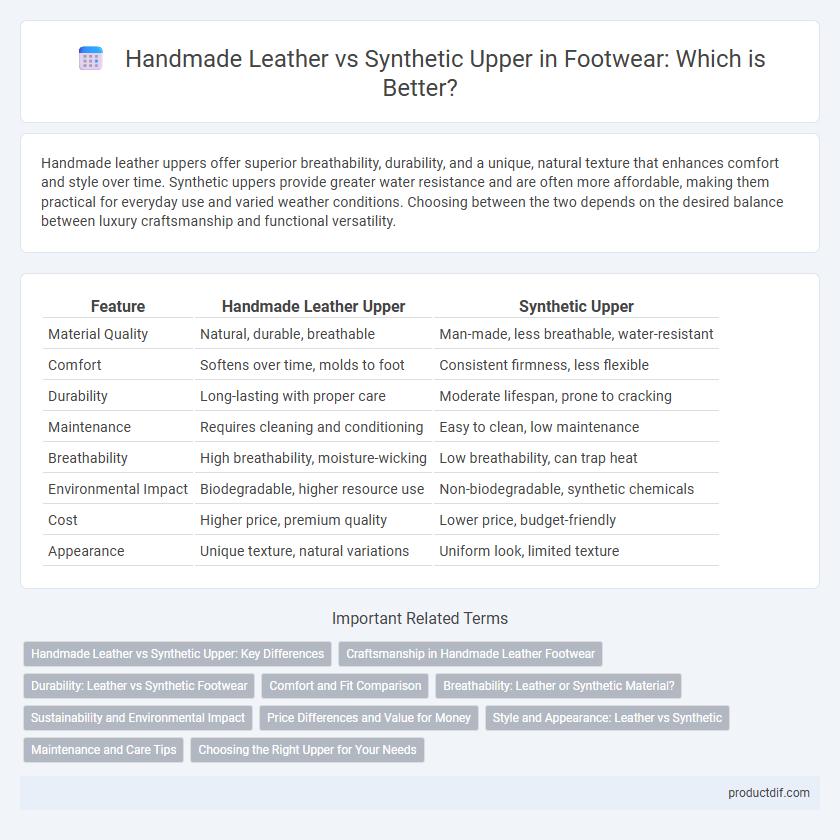Handmade leather uppers offer superior breathability, durability, and a unique, natural texture that enhances comfort and style over time. Synthetic uppers provide greater water resistance and are often more affordable, making them practical for everyday use and varied weather conditions. Choosing between the two depends on the desired balance between luxury craftsmanship and functional versatility.
Table of Comparison
| Feature | Handmade Leather Upper | Synthetic Upper |
|---|---|---|
| Material Quality | Natural, durable, breathable | Man-made, less breathable, water-resistant |
| Comfort | Softens over time, molds to foot | Consistent firmness, less flexible |
| Durability | Long-lasting with proper care | Moderate lifespan, prone to cracking |
| Maintenance | Requires cleaning and conditioning | Easy to clean, low maintenance |
| Breathability | High breathability, moisture-wicking | Low breathability, can trap heat |
| Environmental Impact | Biodegradable, higher resource use | Non-biodegradable, synthetic chemicals |
| Cost | Higher price, premium quality | Lower price, budget-friendly |
| Appearance | Unique texture, natural variations | Uniform look, limited texture |
Handmade Leather vs Synthetic Upper: Key Differences
Handmade leather uppers offer superior durability, breathability, and natural comfort compared to synthetic materials, which often prioritize affordability and water resistance. Leather undergoes a complex tanning process, enhancing its strength and ability to mold to the foot, while synthetic uppers are typically manufactured from polyurethane or polyester, providing uniformity and easy maintenance. The choice between handmade leather and synthetic uppers impacts footwear longevity, aesthetic quality, and overall foot health.
Craftsmanship in Handmade Leather Footwear
Handmade leather footwear showcases superior craftsmanship through meticulous hand-stitching and precise cutting, ensuring durability and a unique fit that synthetic uppers often lack. The natural properties of leather provide breathability and adaptability, enhancing comfort and longevity compared to mass-produced synthetic materials. Artisans blend traditional techniques with premium hides, resulting in shoes that not only perform better but also age gracefully over time.
Durability: Leather vs Synthetic Footwear
Handmade leather uppers offer superior durability due to natural toughness and ability to develop a protective patina over time, often lasting years with proper care. Synthetic uppers, while resistant to water and stains, tend to degrade faster with repeated flexing and exposure to harsh conditions. Investing in handmade leather footwear ensures long-term resilience and maintains structural integrity significantly better than synthetic alternatives.
Comfort and Fit Comparison
Handmade leather uppers provide superior breathability and mold naturally to the foot's shape, enhancing comfort and ensuring a personalized fit over time. Synthetic uppers often offer lightweight and water-resistant properties but may lack the same level of flexibility and breathability, potentially causing discomfort during extended wear. Consumers prioritizing long-term comfort and a tailored fit typically prefer handmade leather for its durability and natural contouring capabilities.
Breathability: Leather or Synthetic Material?
Handmade leather uppers offer superior breathability due to natural pores that allow air circulation, reducing moisture and enhancing comfort during prolonged wear. Synthetic materials, often made from plastic-based fibers, lack these natural properties, trapping heat and sweat, which can lead to discomfort and odor buildup. Choosing leather uppers ensures better moisture management and temperature regulation, making them ideal for breathability in footwear.
Sustainability and Environmental Impact
Handmade leather uppers, sourced from natural hides, offer durability and biodegradability but involve resource-intensive tanning processes often reliant on chemicals with environmental concerns. Synthetic uppers, typically made from petroleum-based polymers, present challenges in biodegradability and microplastic pollution, yet some brands utilize recycled materials to reduce ecological footprint. Evaluating sustainability requires considering factors like raw material sourcing, production emissions, and end-of-life biodegradability for both leather and synthetic options.
Price Differences and Value for Money
Handmade leather footwear often comes with a higher price tag due to the skilled craftsmanship and premium materials involved, offering superior durability and breathability that enhances long-term value for money. Synthetic uppers are generally more affordable, appealing to budget-conscious buyers, but they may lack the same level of comfort, longevity, and aesthetic appeal compared to genuine leather. When evaluating price differences, investing in handmade leather shoes typically provides better overall value through extended wear and timeless style.
Style and Appearance: Leather vs Synthetic
Handmade leather uppers exude a timeless elegance and develop a unique patina over time, enhancing their rich texture and natural color variations. Synthetic uppers offer a sleek, consistent appearance with a wider range of colors and patterns, catering to bold, contemporary styles. Leather generally presents a premium, classic look, while synthetic materials provide versatile, fashion-forward options with a polished finish.
Maintenance and Care Tips
Handmade leather uppers require regular conditioning with natural oils or leather creams to maintain flexibility and prevent cracking, while avoiding excessive water exposure to preserve their durability. Synthetic uppers are easier to clean using mild soap and water, offering resistance to stains and moisture but may degrade faster under harsh UV exposure. Proper storage in a cool, dry place extends the lifespan of both materials, with handmade leather benefiting from occasional polishing to enhance its natural texture and appearance.
Choosing the Right Upper for Your Needs
Handmade leather uppers offer unmatched durability, breathability, and natural molding to the foot, making them ideal for long-term comfort and style. Synthetic uppers provide lightweight, water-resistant, and more affordable options, suitable for active lifestyles and budget-conscious consumers. Selecting the right upper depends on prioritizing durability and natural feel versus cost-effectiveness and weather resistance.
Handmade leather vs Synthetic upper Infographic

 productdif.com
productdif.com